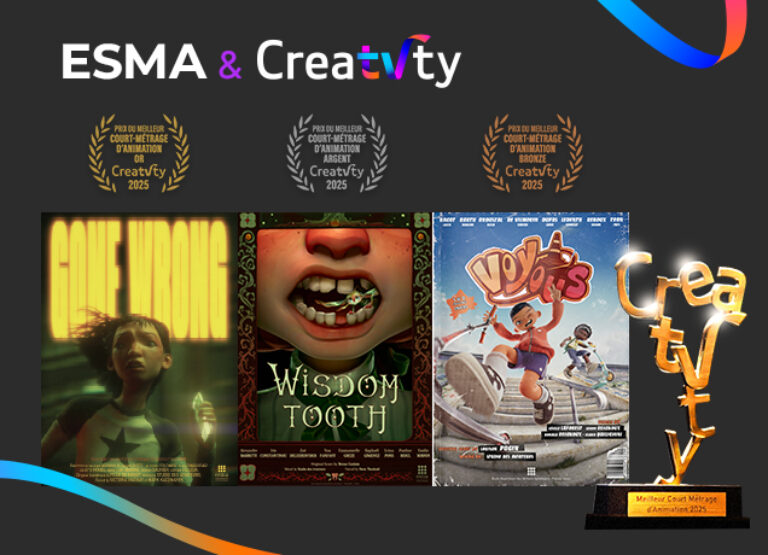
- Published 06.23.2025
- type Thematic news items
- Training 3D Animation & FX
Summarize with:
From 2d or 3d animators to production directors, VFX supervisors, art directors, riggers and concept designers, there are dozens of jobs in the animation industry today. Their diversity and high level of specialization offer a wide range of opportunities for those wishing to enter this sector, which combines creativity and technology. To help you better understand these different professions, let's take a look at some of them.
Why choose a career in Animation?
In 2025, The animation field continues to expand beyond traditional entertainment. Animated content is now integral to gaming, advertising, education, and even virtual production. Professionals in this industry bring characters, environments, and emotions to life—connecting with audiences across all ages. The growth of adult animation, interactive media, and international co-productions has also made this one of the most future-proof creative careers.
Design and pre-production professions
At the origin of every animated creation, there are many artists, technicians and professionals who work together long before the first animated image appears on the computer screen or drawing board. These people, who work together from the very start of the project, include, of course, the scriptwriter and the director, but also:
- The production manager, responsible for coordinating the entire film production chain;
- The concept artist, who designs the characters and environment in collaboration with the character designer;
- The storyboarder, who transforms the script into a visual narrative by determining – with the director and scriptwriter the shots and framing.

Animation and production professions
Whether it’s traditional cartoons or 3D animation, production roles are essential to bringing a film to life. Among these, of course, is the 2D animator or 3D animator, but there are also many other rolessome artistic, others more technical.
- The artistic director works closely with other department heads to ensure the project’s visual and artistic consistency.
- To ensure the production pipeline runs smoothly and efficiently, the Pipeline TD or technical director oversees the workflow and handles the technical needs of the project.
- In 3D productions, the modeling and rigging departments are responsible for transforming 2D designs into fully realized 3D characters. They also add a digital skeleton to these characters, which allows the animation teams to bring them to life.
- Using advanced animation software, the 3D animator breathes emotion and warmth into the film’s characters and into everything that requires animation, including the camera, which often moves dynamically through the scenes.
- The surfacing, lighting, and VFX teams work together to create textures, moods, and visual elements like water effects, fire, or even crowd scenes.
- Finally, the rendering artist brings all the images together using powerful software tools. This role requires both strong technical skills and artistic sensitivity—skills that are usually developed through in-depth 3D animation training.

Post-production and special effects professions
Once the film creation process is well underway, we move into the post-production phase. Here too, there’s a wide range of roles. While the editor plays a key part adjusting both sound and image as in live-action films—other roles are just as essential when it comes to animation.
-
Compositing teams compile the different render layers and fine tune the lighting, color, shadows, and more to ensure the film’s visual consistency.
-
Post-production is also the moment to add final visual effects, completing certain scenes with the finishing touches.
-
These teams work under the supervision of a production manager, who collaborates closely with the director to bring the project to completion.

In the era of digital cinema, it is important to note that VFX artists may be called upon to work on both animated films and live-action projects. Cinema increasingly relies on digital special effects, both in big American productions and in independent films, where the expertise of VFX artists can enrich the universe and solve technical challenges that would be impossible to achieve through mechanical special effects.
Average salary for Animation careers
Salaries vary depending on the jobs mentioned above. On average, the annual salary of a 3D animator varies between:
- Entry-Level Animator: 25,000€ – 35,000€ annually
- Mid-Level Animator: 35,000€ – 55,000€ annually
- Senior or Lead Roles: 55,000€ and above
The more specialized the job, and the more the person has managed to develop unique expertise, the more opportunities they will have to reach a higher salary level. In the case of international productions, these salaries may also vary. This is why it is necessary to build a solid foundation through quality training.

Training to work in 3D animation
To build a strong foundation in 3D animation and visual effects careers, a 3D training program that combines both artistic and technical skills is essential. This training also allows students to choose their own specialization through a comprehensive program, guided by professionals and in direct contact with the animation film industry. An ideal and necessary springboard to launch into an exciting field!
In conclusion, animation cinema is a sector offering careers that are much more varied than one might think. Technical roles, artistic paths, team and project management many opportunities exist, and a wide range of profiles can find their calling here.
In conclusion
Animated film is a field that offers a much wider range of careers than you might think. From technical and artistic roles to team and project management, there are many different challenges to tackle, and a wide variety of people can find their calling here.




